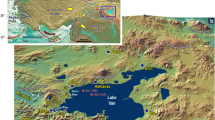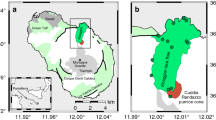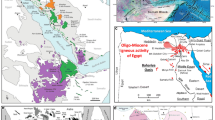Abstract
The Mono Basin has been the site of frequent volcanic activity over the past 60,000 years, including the emplacement of the Mono domes and Mono Lake islands. The Mono Basin lavas are the youngest and most poorly understood products of the Long Valley Volcanic Field. We have undertaken a study of Mono Basin volcanism encompassing whole-rock major and trace element, Sr, Nd, Pb, and O isotopic, and electron microprobe glass, plagioclase, and amphibole analyses. Variations in major and trace elements suggest that fractional crystallization of feldspar (Sr, K2O), apatite (P2O5), titanomagnetite (V), zircon (Zr), and allanite (La, Ce) has influenced the evolution of the Mono Basin lavas. Field observations, petrography, and chemistry together demonstrate that injection of more mafic magma is a common process throughout the Mono Basin. Mafic enclaves of the Mono domes are stretched and rounded, with chilled margins between enclave and host rhyolite. Thin sections reveal millimeter-scale inclusions of rhyolite in the enclaves and vice versa along the host-enclave border. Paoha Island dacite has glass with 67–72 wt% SiO2 and contains microscopic clots of more mafic glasses, with SiO2 contents as low as 64 wt%. Isotopically, the June Lake and Black Point basalts and the Mono dome enclaves represent the least evolved material in the Long Valley Volcanic Field, with 87Sr/86Sri <0.7056 and 143Nd/144Nd >0.5126. The silicic Mono Lake lavas and Mono dome rhyolites display a significant crustal component, with 87Sr/86Sri >0.7058 and 143Nd/144Nd <0.5127. Oxygen and Pb isotopes throughout the sample suite also have crustal signatures, with 206Pb/204Pb >19 and δ18O >+6.5‰. The Mono Lake lavas generally are younger and less evolved than the Mono domes, with enrichment in trace elements including Ba and Sr accompanied by lower 143Nd/144Nd and higher 206Pb/204Pb. This implies that the Mono domes and the Mono Lake lavas are derived from different magma batches, if not from separate magma chambers. There is no systematic relationship between the degree of chemical evolution and the lava ages, indicating that several magma batches have been involved in the development of the Mono domes complex. Pronounced differences in trace element composition (Nb, Y) and isotopic values between the Negit Island and Paoha Island lavas indicate that they, too, are produced by the evolution of at least two different batches of intermediate-composition magma.















Similar content being viewed by others
References
Achauer U, Greene L, Evans JR, Iyer HM (1986) Nature of the magma chamber underlying the Mono Craters area, eastern California, as determined from teleseismic travel time residuals. J Geophys Res 91:13873–13891
Bailey RA (1989) Geologic map of Long Valley caldera, Mono-Inyo Craters volcanic chain, and vicinity, eastern California. US Geol Surv Misc Investig Ser Map I-1933, 11 pp, scale 1:62,500, 2 sheets
Bailey RA (2004) Eruptive history and chemical evolution of the precaldera and postcaldera basalt-dacite sequences, Long Valley, California: implications for magma sources, current seismic unrest, and future volcanism. US Geol Surv Prof Pap 1692:76
Battaglia M, Roberts C, Segall P (1999) Magma intrusion beneath Long Valley caldera confirmed by temporal changes in gravity. Science 285:2119–2122
Bindeman I (2008) Oxygen isotopes in mantle and crustal magmas as revealed by single crystal analysis. Rev Mineral Geochem 69:445–478
Blundy J, Cashman K, Humphreys M (2006) Magma heating by decompression-driven crystallization beneath andesite volcanoes. Nature 443:76–80
Bursik M, Sieh KE (1989) Range front faulting and volcanism in the Mono Basin, eastern California. J Geophys Res 94:15587–15609
Bursik MI, Gillespie AR (1993) Late Pleistocene glaciation of Mono Basin, California. Quat Res 39:24–35
Bursik M, Renshaw C, McCalpin J, Berry M (2003) A volcanotectonic cascade: activation of range front faulting and eruptions by dike intrusion, Mono Basin-Long Valley caldera, California. J Geophys Res Solid Earth 108:B8
Bursik M, Sieh K (2013) Digital database of the Holocene tephras of the Mono-Inyo Craters, California. US Geol Surv Data Ser 758
Bursik M, Sieh K, Meltzner A (2014) Deposits of the most recent eruption in the southern Mono Craters, California: description, interpretation and implications for regional marker tephras. J Volcanol Geotherm Res 275:114–131
Chaudet RE (1986) The petrology and geochemistry of precaldera magmas, Long Valley caldera, eastern California. MSc thesis, Virginia Polytechnic Institute
Christensen JN, DePaolo DJ (1993) Time scales of large volume silicic magma systems: Sr isotopic systematics of phenocrysts and glass from the Bishop Tuff, Long Valley, California. Contrib Mineral Petr 113:100–114
Clayton RN, Mayeda TK (1963) The use of bromine pentafluoride in the extraction of oxygen from oxides and silicates for isotopic analysis. Geochim Cosmochim Acta 27:43–52
Cousens BL (1996) Magmatic evolution of Quaternary mafic magmas at Long Valley caldera and the Devils Postpile, California: effects of crustal contamination on the lithospheric mantle-derived magmas. J Geophys Res 101:27673–27689
Crowley JL, Schoene B, Bowring SA (2007) U-Pb dating of zircon in the Bishop Tuff at the millennial scale. Geology 35:1123–1126
Davies GR, Halliday AN (1998) Development of the Long Valley rhyolitic magma system: strontium and neodymium isotope evidence from glasses and individual phenocrysts. Geochim Cosmochim Acta 62:3561–3574
Dawson PB, Evans JR, Iyer HM (1990) Teleseismic tomography of the compressional wave velocity structure beneath the Long Valley region, California. J Geophys Res 95:11021–11050
Devine JD, Gardner JE, Brack HP, Layne GD, Rutherford MJ (1995) Comparison of microanalytical methods for estimating H2O contents of silicic volcanic glasses. Am Mineral 80:319–328
Google, TerraMetrics (2016) Long Valley caldera. Google Maps. https://www.google.com/maps/place/Long+Valley+Caldera/@37.8023694,-119.1960395,76495m/data=!3m1!1e3!4m5!3m4!1s0x8096103d4842abcb:0xe21752c39e238391!8m2!3d37.7165993!4d-118.8843024. Accessed 25 October 2016.
Halliday AN, Fallick AE, Hutchinson J, Hildreth W (1984) A Nd, Sr and O isotopic investigation into the causes of chemical and isotopic zonation in the Bishop Tuff, California. Earth Planet Sc Lett 68:379–391
Heumann A, Davies GR (1997) Isotopic and chemical evolution of the post-caldera rhyolitic system at Long Valley, California. J Petr 38:1661–1678
Hildreth W (2004) Volcanological perspectives on Long Valley, Mammoth Mountain, and Mono Craters: several contiguous but discrete systems. J Volcanol Geotherm Res 136:169–198
Hildreth W, Fierstein J, Champion DE, Calvert AT (2014) Mammoth Mountain and its mafic periphery—a late Quaternary volcanic field in eastern California. Geosphere 10:1315–1365
Hill DP, Bailey RA, Ryall AS (1985) Active tectonic and magmatic processes beneath Long Valley caldera, eastern California: an overview. J Geophys Res 90:11111–11120
Hill DP, Prejean S (2005) Magmatic unrest beneath mammoth mountain, California. J Volcanol Geoth Res 146:257–283
Hu Q, Smith PE, Evensen NM, York D (1994) Lasing in the Holocene: extending the 40Ar/39Ar laser probe method into the 14C age range. Earth Planet Sc Lett 123:331–336
Johnson DM, Hooper PR, Conrey RM (1999) XRF analysis of rocks and minerals for major and trace elements on a single low dilution Li-tetraborate fused bead. Adv X Ray Anal 41:843–867
Kelleher PC (1986) The Mono Craters-Mono Lake islands volcanic complex, eastern California: evidence for several magma types, magma mixing, and a heterogeneous source region. MSc thesis, University of California Santa Cruz
Kelleher PC, Cameron KL (1990) The geochemistry of the Mono Craters-Mono Lake volcanic complex, eastern California. J Geophys Res 95:17643–17659
Lackey JS, Valley JW, Chen JH, Stockli DF (2008) Dynamic magma systems, crustal recycling, and alteration in the Central Sierra Nevada Batholith: the oxygen isotope record. J Petr 49:1397–1426
Lajoie KR (1968) Late Quaternary stratigraphy and geologic history of Mono Basin, eastern California. PhD dissertation, University of California Berkeley
Marcaida M, Mangan MT, Vazquez JA, Bursik M, Lidzbarski MI (2014) Geochemical fingerprinting of Wilson Creek formation tephra layers (Mono Basin, California) using titanomagnetite compositions. J Volcanol Geoth Res 273:1–14
Miller CD (1985) Holocene eruptions of the Inyo Volcanic Chain, California: implications for possible eruptions in Long Valley caldera. Geology 13:14–17
Nelson ST, Montana A (1992) Sieve-textured plagioclase in volcanic rocks produced by rapid decompression. Am Mineral 77:1242–1249
Ormerod DS (1988) Late- to post-subduction magmatic transitions in the western Great Basin, U.S.A. PhD dissertation, Open University
Pakiser LC, Press F, Kane MF (1960) Geophysical investigation of Mono Basin, California. GSA Bull 71:415–448
Peacock JR, Mangan MT, McPhee D, Ponce DA (2015) Imaging the magmatic system of Mono Basin, California, with magnetotellurics in three dimensions. J Geophys Res Solid Earth 120:7273–7289
Ridolfi F, Renzulli A, Puerini M (2009) Stability and chemical equilibrium of amphibole in calc-alkaline magmas: an overview, new thermobarometric formulations and application to subduction-related volcanoes. Contrib Mineral Petr 160:45–66
Riley P, Tikoff B, Hildreth W (2012) Transtensional deformation and structural control of contiguous but independent magmatic systems: Mono-Inyo Craters, Mammoth Mountain, and Long Valley caldera, California. Geosphere 8:740–751
Sampson DE, Cameron KL (1987) The geochemistry of the Inyo volcanic chain: multiple magma systems in the Long Valley region, eastern California. J Geophys Res 92:10403–10421
Sarna-Wojcicki AM, Lajoie KR, Meyer CE, Adam DP, Robinson SW, Anderson RS (1988) Tephrochronologic studies of sediment cores from Walker Lake. Nevada US Geol Surv Open File Rep:88–548
Sieh KE, Bursik MI (1986) Most recent eruption of the Mono Craters, eastern Central California. J Geophys Res 91:12539–12571
Sparks RJS, Sigurdsson H, Wilson L (1977) Magma mixing: a mechanism for triggering acid explosive eruptions. Nature 267:315–318
Stine S (1987) Mono Lake: the past 4000 years. Dissertation, University of California Berkeley
Stix J, Gauthier G, Ludden JN (1995) A critical look at quantitative laser-ablation ICP-MS analysis of natural and synthetic glasses. Can Mineral 33:435–444
Todt W, Cliff RA, Hanser A, Hoffmann AW (1996) 202Pb-205Pb double spike for high-precision lead isotope analysis. In: Basu A, Hart SR (eds) Earth processes: reading the isotopic code, AGU geophysical monograph, vol 95. AGU, Washington, pp 429–437
Van Kooten GK (1981) Pb and Sr systematics of ultrapotassic and basaltic rocks from the central Sierra Nevada, California. Contrib Mineral Petr 76:378–385
Varga RJ, Bailey RA, Suemnicht GA (1990) Evidence for 600 year-old basalt and magma mixing at Inyo Craters volcanic chain, Long Valley caldera, California. J Geophys Res 95:21441–21450
Vazquez JA, Lidzbarski MI (2012) High-resolution tephrochronology of the Wilson Creek formation (Mono Lake, California) and Laschamp event using 238U-230Th SIMS dating of accessory mineral rims. Earth Planet Sc Lett 357-358:54–67
Wark DA, Hildreth W, Spear FS, Cherniak DJ, Watson EB (2007) Pre-eruption recharge of the Bishop magma system. Geology 35:235–238
White JDL (2000) Subaqueous eruption-fed density currents and their deposits. Precambrian Res 101:87–109
Wood SH (1983) Chronology of late Pleistocene and Holocene volcanics, Long Valley and Mono Basin geothermal areas, eastern California. US Geol Surv Open File Rep:83–747
Zimmerman SR, Hemming SR, Hemming NG, Tomascak PB, Pearl C (2011) High-resolution chemostratigraphic record of late Pleistocene lake-level variability, Mono Lake, California. Geol Soc Am Bull 123:2320–2334
Acknowledgements
Dave Marquart of the Mono Lake Tufa State Natural Reserve and Tamara Sasaki of California State Parks were instrumental in ensuring that we received the proper permits needed to explore Negit and Paoha. Dan Dawson, Kim Rose, and the rest of the staff of the Sierra Nevada Aquatic Research Lab provided us with housing and lab space during the 2012 field season. Bartshe Miller and the volunteers of the Mono Lake Committee let us rent their boat on several occasions. Kristie Nelson was a keen observer and faithful companion in the field. Patrick Beaudry and Gregor Lucic were able field assistants in the summer of 2012.
Paul Alexandre, Kristen Feige, and the rest of the Queen’s Facility for Isotope Research staff assisted with oxygen isotope determinations, and Rhea Mitchell at the Carleton Isotope Geochemistry and Geochronology Research Centre was unflagging in her efforts to make sure that we obtained the best radiogenic isotope data possible. Dr. Wes Hildreth of the U.S. Geological Survey read an early draft of this manuscript. We are grateful to him for his comments and suggestions. This research was supported by Discovery and Accelerator grants to J. Stix from the Natural Sciences and Engineering Research Council of Canada, as well as a grant to B. Bray from the University of California Valentine Eastern Sierra Reserve.
Author information
Authors and Affiliations
Corresponding author
Additional information
Editorial responsibility: M.I. Bursik
Rights and permissions
About this article
Cite this article
Bray, B., Stix, J. & Cousens, B. Mafic replenishment of multiple felsic reservoirs at the Mono domes and Mono Lake islands, California. Bull Volcanol 79, 54 (2017). https://doi.org/10.1007/s00445-017-1123-y
Received:
Accepted:
Published:
DOI: https://doi.org/10.1007/s00445-017-1123-y




